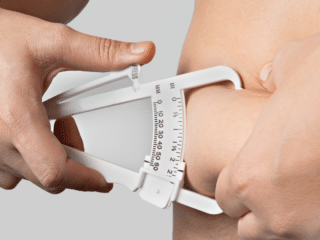Are You Still Trying To Figure Out How To Measure Your Body Fat Percentage Without Leaving Your House?
The good news
There are some ways you can get an estimate without investing more than $5 to get started.
The bad news
If you are serious about tracking your body fat percentage, you should invest in a good tool.
Where to Start?
Here are 4 options to choose from when starting out.
1. Body Fat Calculator
Try our body fat calculator.
Just fill in your age, height, and weight to get a rough estimate.
[fcp-bfc-calculator]
This obviously is not the most accurate but you can have a ballpark figure to get started.
2. Body Circumference
The quickest way to start measuring your body fat percentage is using a measuring tape and get your waist to height ratio.
How does it work?
- Measure your waist
- Measure your height
- Divide waist/height
- Find your result in the following table to get an estimate.
3. Body Impedance Analysis (BIA) – Smart Scales
Smart Scales have become very popular, especially the ones that have an ecosystem around them that include Fitness Trackers to complement them.
The amount of smart scales out there is huge, so here is an example of the most important aspects to analyze when deciding which one to buy.
| Fitbit Aria Air | Withings Body + | Wyze Scale | |
| Price | $49.95 | $99.00 | $31.99 |
| Fitness Tracker | ✔ | X | X |
| Multi-User | ✔ | ✔ | ✔ |
| Body Fat Percentage | ✔ | X | X |
| Pregnancy Mode | X | ✔ | X |
| Wifi Enabled | ✔ | ✔ | X |
| Bluetooth Enabled | ✔ | ✔ | ✔ |
| Android/IOs | ✔ | ✔ | ✔ |
Notice that not all smart scales measure your body fat percentage. These are 3 random smart scales but make sure when analyzing them; the body fat percentage is included in the specs.
4. Body Fat Caliper
Body fat calipers are used for measuring different areas of the body to estimate your body fat percentage.
- Waist
- Bicep
- Tricep
- Shoulder Blade

You need to measure the skinfold in each area to be accurate.
You need to add the 4 measurements in mm, and once you have your total mm, you can use this chart to obtain your body fat percentage.
Is It Worth The Trouble?
In my case, it was a game-changer. Monitoring only your weight and BMI didn’t really give me the feedback I needed to track my goals every week.
Here is a quick example of how only weight could be misleading.
| Total Weight | Body Fat % | Lean Mass | Fat Mass | |
| Week 1 | 180 lbs | 20% | 144 lbs | 36 lbs |
| Week 2 | 178 lbs | 19.6% | 143 lbs | 35 lbs |
| Week 3 | 176 lbs | 19.3% | 142 lbs | 34 lbs |
| Week 4 | 174 lbs | 19% | 141 lbs | 33 lbs |
In this example, you can see that every week the person is losing 2 pounds per week, but that person is losing 1 pound of fat and 1 pound of muscle each week.
What many people usually would assume would be the following:
I want to reach a 17% fat percentage. I divide my lean mass by (1- target fat percentage) 144 /0.83.
This result gives me the target weight goal I need to reach (173.5 pounds). Then you start losing weight and only reduce 1% of body fat instead of the 3% you calculated.
What happened?
You didn’t contemplate that muscle can also be going down.
The same thing might happen when bulking. You might be gaining weight, but it’s not necessarily muscle; fat can be increasing.
So if you are interested in body recomposition, I definitely recommend that you start tracking your body fat percentage.